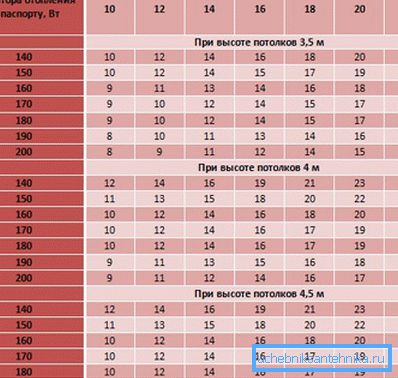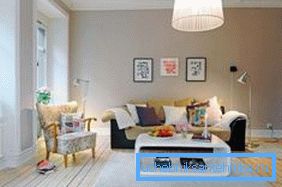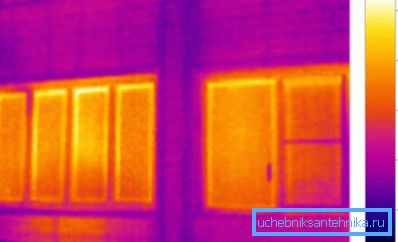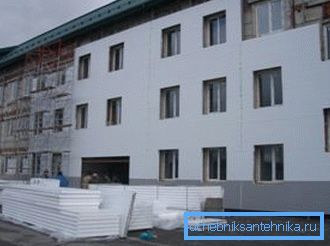Calculation of heating radiators per square meter: options
This article is about how many squares one radiator section is designed for. We will figure out how to calculate the number of sections with a known area of the room, and find out what additional factors affect the heat demand of a house or apartment.

Simple area calculation
Option 1
In the first approximation, the number of radiators per square meter can be calculated using the simplest scheme: one section heats 2 m2 of living space. Therefore, for a room of 20 m2, there is enough battery in ten sections.
The instruction is extremely simple, affordable and gives extremely inaccurate results. The reasons?
You are welcome:
- According to the Soviet SNiP for a temperate climate zone, the radiator power per square meter should be equal to 100 watts. Let me ask, dear reader: for which part of Russia is a temperate climate characteristic? Clearly not for all, is it?
Reference: heat consumption through the enclosing structures with the same structure of insulation is proportional to the temperature difference with the street. At +20 in the room, the need for heat for the outdoor temperature at 0 and at -40 will differ exactly three times.
- The given calculation scheme implies that the radiator section gives 200 watts of heat. Meanwhile, this heat transfer is typical only for aluminum and bimetallic radiators at a coolant temperature of 90 degrees. Agree that how many squares one section of aluminum radiator heats in ideal conditions will be quite bold to extend to all types of heating appliances.

Option 2
We will get a more accurate result if we divide the calculations into two steps:
- First, we calculate the need for heat for the room, taking into account the climatic zone;
- Then we find the required number of sections of heating devices, taking into account their real heat transfer.
The need for heat per square meter for different climatic zones is as follows:
| Region | The need for heat, watts / m2 |
| Krasnodar region | 70 |
| Moscow region | 120 |
| Novosibirsk region | 150 |
| Khabarovsk region | 160 |
| Chukotka, Yakutia | 200 |
But the averaged values of heat transfer from different heating devices for the coolant temperature are +90 and room temperature is +20:
| Type of radiator | Heat flow, watts / section |
| Aluminum | 200 |
| Bimetallic | 180 |
| Cast iron | 160 |
| Steel | 120 |
To clarify: the calculation of steel heating radiators over the quadrature of a room using the nominal rated power will give a somewhat accurate result only for tubular sectional devices. In the case of panel radiators and heating convectors, you can rely solely on their passport characteristics.

Let us, as an example, do your own calculations for steel radiators per square meter and for the entire floor space for a 20-meter room in Yakutsk.
- One section of a tubular battery is capable of heating 120/200 = 0.6 m2 room.
- The total heat demand for a room will be 20 * 200 = 4000 watts, which corresponds to 4000/120 = 33 (with rounding) sections.
Calculation by volume
In some cases, the question of how many radiator sections per square meter are necessary for heating is completely meaningless.
When exactly?
- With non-standard ceiling height. Heating will warm the entire volume of the dwelling; You will agree that this volume will differ noticeably with a ceiling height of 2.5 and 4.5 meters.

- With the quality of insulation, significantly different from that recommended by domestic building codes. The value of 100 watts / m2 was relevant for typical projects of houses of the Soviet era; modern, energy-efficient buildings, even with a standard ceiling height, require no more than 60 W / m2.
Option 1
The first calculation scheme is suitable for rooms with non-standard ceiling heights and standard insulation.
- 40 watts of thermal power is taken per cubic meter of room volume;
- For corner and end rooms in an apartment building, a factor of 1.2 is used, for extreme floors, 1.3, for detached private houses, 1.5;
- The window adds 100 watts to the heat loss, the door leading to the street - 200;

- A regional coefficient is introduced (0.7 - 2.0 depending on the climatic zone).
Let's once again calculate the need for heat in our room in Yakutsk, specifying that the ceiling height in it is 3.2 meters, the room is located on the first floor and has two windows.
- The volume with an area of 20 m2 will be 20 * 3.2 = 64 m3.
- Multiply the volume on the base 40 watts / m3: 64 * 40 = 2560.
- The first floor increases heat loss through the ceiling: 2560 * 1.3 = 3328.
- Two windows add 200 watts to this value. 3328 + 200 = 3528.
- The climate of Yakutsk (the average January temperature is -38 ° C) forces to use the maximum value of the regional coefficient: 3528 * 2 = 7056.
Recounting this power in the number of sections of aluminum batteries, we will come to a state of slight panic: for heating, you need 35 sections! And it is in perfect conditions.
Option 2
In practice, if the thermal power is calculated by quadrature, the heating radiators will be too much for the area of the room. The fact is that the high price of energy makes builders improve the quality of thermal insulation of buildings.

For rooms with arbitrary height of ceilings and non-standard insulation, the following formula for calculating the heat output is used:
Q = V * Dt * k / 860.
In it:
- Q - power in kilowatts;
- V - volume in cubic meters;
- Dt is the calculated temperature difference with the street (the delta between the sanitary standard of the room temperature and the average minimum of winter);
- k is the coefficient of the degree of warming.
The values of k are taken equal:
- For buildings with a triple energy-saving glazing and outdoor foam or mineral wool coat - 0.6-0.9;
- For a brick home with a wall thickness of 500 mm and double glazing - 1-1.9;
- For brick buildings with a wall thickness of 250 mm and single-glazed windows - 2-2.9;
- For non-insulated buildings - 3-4.

For our conditions:
- The volume of the room we have already calculated and is 64 m3;
- Dt = 22 - (-41.5) = 63.5 C;
- The coefficient of heat insulation for all new houses being built in the conditions of the Far North can be safely taken equal to 0.6 - 0.8.
- The calculation takes the form Q = 64 * 63.5 * 0.6 / 860 = 2.84 kW.
Conclusion
Which of the calculation schemes will seem to the reader the most suitable for his conditions is up to him. Additional thematic information can be obtained by viewing the attached video in this article. Successes!